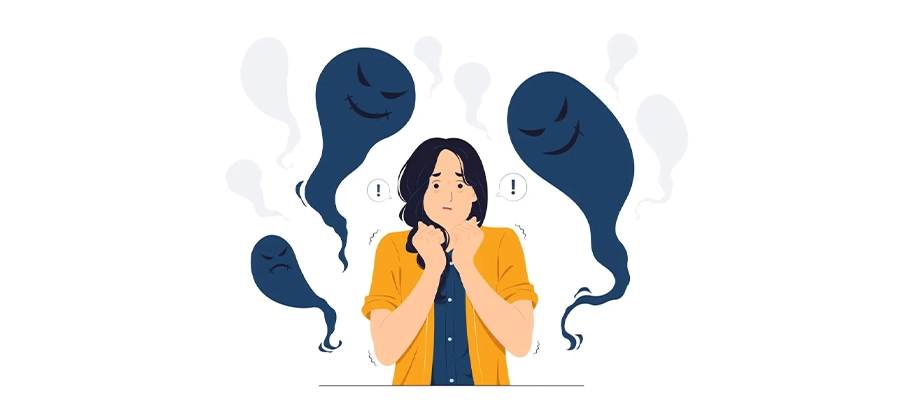A phobia is an excessive, uncontrollable, and persistent fear of a specific object, situation, or activity. Unlike normal fear, which is a protective response to danger, phobias are irrational and disproportionate to the actual threat. The anxiety can become so overwhelming that individuals often go to great lengths to avoid whatever triggers their fear. In some cases, encountering or even imagining the feared object or situation can lead to a panic attack, which involves sudden, intense fear along with physical symptoms such as shortness of breath, palpitations, dizziness, and sweating—even when no real danger is present.
Research suggests that specific phobias are widespread, with lifetime prevalence rates estimated between 3% and 15% globally. Among the most common fears are those related to heights, animals, confined spaces, and natural phenomena like thunderstorms. Phobias usually follow a progression: an initial fear, followed by avoidance behaviors, which eventually lead to functional impairment and a formal diagnosis. This pattern highlights the importance of early intervention to prevent the phobia from becoming chronic or leading to other mental health conditions.
Phobias frequently begin in childhood, especially between the ages of 5 and 9. However, many adult phobias first develop in early adulthood or midlife, and are less likely to resolve without professional treatment. In fact, studies show that 10–30% of phobias can persist for several years or even decades. Additionally, phobias are associated with an increased risk of developing other psychiatric disorders, including anxiety disorders, mood disorders, and substance use problems. The high comorbidity rate suggests that treating phobias early might reduce the risk of more complex mental health conditions later.
According to the DSM-5-TR (Diagnostic and Statistical Manual of Mental Disorders, Text Revision), a specific phobia diagnosis requires several key features. First, the individual must experience marked fear or anxiety about a particular object or situation, such as heights, animals, or flying. This fear is immediate and intense upon exposure, often leading to active avoidance behaviors. The fear is considered out of proportion to the actual danger, and it must persist for at least six months. Importantly, the phobia must cause clinically significant distress or impairment in social, occupational, or daily functioning. Lastly, the symptoms cannot be better explained by other mental health conditions such as obsessive-compulsive disorder (OCD), post-traumatic stress disorder (PTSD), or social anxiety disorder.
There are three main types of phobia commonly identified in clinical practice. The first is Specific Phobia, which involves intense fear of particular objects or situations. Common examples include fear of animals (like snakes, spiders, or dogs), certain environments (such as darkness, heights, or storms), or specific situations (such as flying, using elevators, or undergoing medical procedures). Many specific phobias seem to run in families, suggesting both genetic and environmental factors play a role.
The second type is Social Anxiety Disorder, previously known as social phobia. People with this condition experience extreme fear of social interactions or performance situations due to concerns about embarrassment, humiliation, or negative judgment from others. This may be limited to specific events, such as public speaking, or more generalized, affecting everyday activities like eating in public or attending social gatherings. Individuals who were shy or socially withdrawn as children, or those who had negative social experiences, are at higher risk of developing this disorder.
The third type is Agoraphobia, which involves a fear of being in places where escape might be difficult or help unavailable if anxiety symptoms occur. Commonly feared situations include public transportation, crowded places, or being far from home. People with agoraphobia often avoid such places, sometimes becoming housebound. Agoraphobia may occur alongside panic disorder, but it can also present on its own.
Despite the prevalence of phobias, treatment-seeking rates remain low. Research suggests that only 10% to 25% of people with specific phobias receive professional help. This may be because avoidance can temporarily reduce distress, creating the illusion of control, even though it worsens the condition over time. People are more likely to seek treatment if their phobia causes severe impairment, involves situations that are hard to avoid (like flying or using elevators), or if they have multiple phobias.
When it comes to treatment options, Exposure Therapy is considered the most effective and evidence-based approach for specific phobias. This involves gradually and repeatedly facing the feared object or situation in a controlled and safe environment, either in real life (in-vivo exposure) or through imagery and imagination. Over time, this process helps reduce the fear response through habituation. Virtual Reality Exposure Therapy (VRET) is also gaining popularity, especially for phobias where real-life exposure is difficult, such as fear of flying or heights.
Another effective treatment is Cognitive Behavioral Therapy (CBT). In addition to exposure, CBT helps individuals identify and challenge irrational thoughts and catastrophic predictions related to their phobia. For example, someone with a fear of elevators may believe, 'If I get in an elevator, it will crash.' CBT teaches techniques to replace such thoughts with more realistic, balanced thinking.
For certain phobias, especially blood-injection-injury phobia, specific techniques like applied tension are used to prevent fainting by teaching the person to tense their muscles during exposure. Relaxation training and controlled breathing techniques are also helpful for managing the physical symptoms of panic that often accompany phobias.
In some cases, medications may be prescribed. For example, SSRIs (Selective Serotonin Reuptake Inhibitors) are commonly used for social anxiety disorder or agoraphobia with panic symptoms. Beta-blockers may also be used on a short-term basis for performance-related social anxiety.
Newer therapeutic approaches, such as Acceptance and Commitment Therapy (ACT), focus on helping individuals accept their fearful thoughts without letting those thoughts control their behavior. Mindfulness techniques are also being integrated into treatment to help manage anxiety in the moment.
In conclusion, phobias are common but highly treatable mental health conditions. With early and appropriate intervention, most individuals can significantly reduce their fears and improve their quality of life. As clinical psychologists, our goal is to help clients understand their fears, face them gradually, and regain control over the areas of life that avoidance has taken away. Treatment not only reduces current distress but also lowers the risk of developing additional psychological problems in the future.

